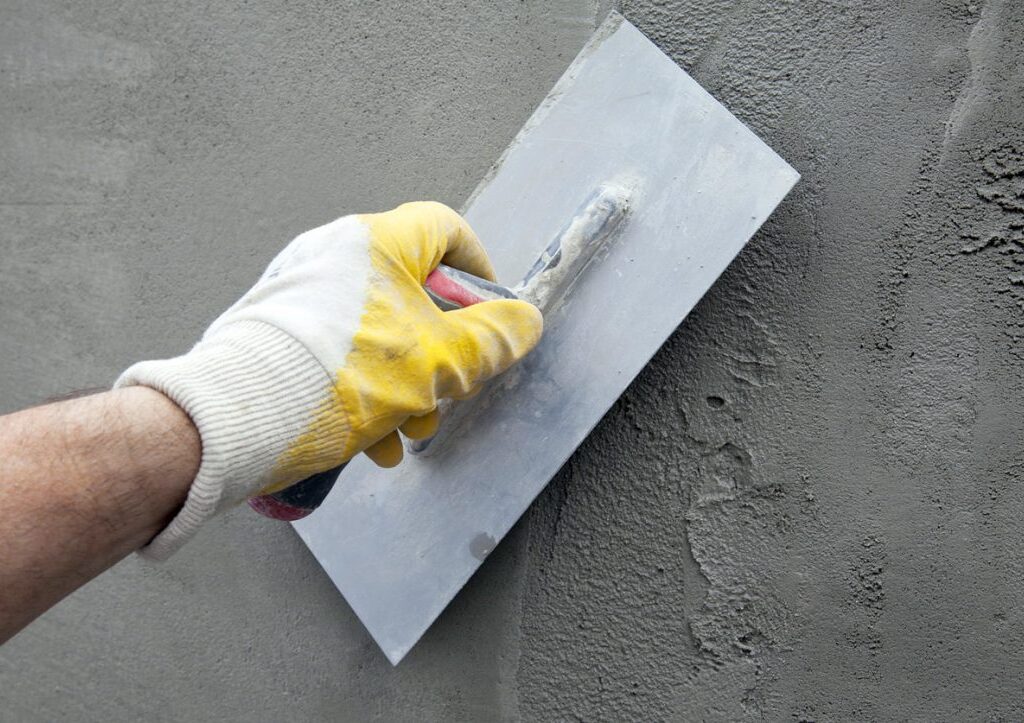Plastering Work
Plastering is the crucial point of house production process since it must be the last look after completing grey structure. All wrongdoings or defects if any in brick work of walls must be covered or minimized during plaster. There are many technical points that should be prevented in mind before and after plastering a wall to get a silky and perfect finish. Earlier plastering wall should not be dry and should be cured with clean water to maximum limit until the bricks stop absorbing water. However, this process should be taken out at least 8-10 hours before plastering the walls. If this curing is carried out right before plaster, mortar will not settle on walls or if it settles or cracks will appear when it dries. Cement putting is regularly applied to give ideal covering to the outside and inside surface of the divider. Cement mortar is typically given in a solitary coat or twofold coat. Twofold coat mortar is appropriate where the thickness of mortar is held more than 15 mm or when it is important to keep a fine completion. The strategy for twofold coat Cement mortar includes the accompanying 5 stages.

- Stage one is Making the surface prepared for putting.
- Stage two is Groundwork for mortar.
- When stage three is giving first coat (or undercoat or delivering coat)
- Then stage four is Providing second coat (or completing coat or fine coat)
PREPARING THE SURFACE FOR PLASTERING
Hold all the mortar joints of divider harsh, to keep a decent clinging to hold mortar. Utilize a wire brush to scrub every one of the joints and surfaces of the divider with a wire brush, the divider surface does not contain any oil or oil and so forth left on the divider surface. If the surface is smooth, or the putting divider is old, at that point extricate the mortar joint to a profundity of least 12 mm to give a better holding than the mortar. If the projection on the divider surface remaining parts more than 12 mm, wipe it out to keep a smooth surface of the divider. It will limit the utilization of mortar. For any holes or openings on a superficial level, fill it with accurate material already. Roughen the entire divider to be put. Wash the mortar joints and entire divider to be put and make it wet for at least 6 hours preceding use Cement mortar.
PREPARATION FOR PLASTER
To keep up the smooth thickness of putting all through the divider surface, at first settle specks on the divider. A speck has a place with a fix of mortar with size 15 mm * 15 mm and thickness of around 10 mm. At first, spots are set on the divider evenly and afterward in an upward direction at a separating of around 2 meters covering the entire divider surface. With the assistance of plumb-sway, inspect the verticality of specks, one over the other. When the dabs are set, the upward portions of mortar false name tirades are masterminded among the spots. These tirades work as the checks for holding smooth thickness of putting to be utilized.
GIVING FIRST COAT OR UNDERCOAT OR RENDERING COAT
For block workmanship, the thickness of first coat mortar normally stays 12 mm, and for substantial brickwork, this thickness contrasts from 9 to 15 mm. The extent of Cement and sand for first coat mortar varies from 1:3 to 1:6. By utilizing a scoop, give the principal layer of mortar among the spaces created with the tirades on the divider surface. The surface ought to be evened out with level wooden buoys and wooden straight edges. When the evening out is done, leave the main coat to set however not to dry and afterward roughen it by a scratching apparatus to foster a key to the second layer of mortar.
GIVING SECOND COAT OR FINISHING COAT OR FINE COAT
The thickness of the second coat or completing coat may vary from 2 to 3 mm. The extent of Cement and sand for second coat mortar varies from 1:4 to 1:6. Before giving the subsequent coat, wet the main coat consistently. Furnish the completing coat with wooden buoys to an ideal uniform surface and apply final detail with a steel scoop. If conceivable, the completing coat ought to be given beginning from the top towards the base and completed in one activity to eliminate joining marks.When the putting work is finished, water ought to be sprinkled over it to save clammy for at least 7 days to keep up strength and hardness.
We are a top prominent plastering company servicing the Sunshine Coast area from Tenanting to Pelican Waters. No plastering job is too complicated, too big, or even too small for our squad of professionals to tackle. Should you need a wall fixing or replacing, or a full home renovation, our company is here for you. We really pride ourselves on our workmanship. Our plasterers are skilled, experienced in their fields, and highly competent. In fact, we only those who meet our strict criteria and who share in our imagination and goals. Therefore, our team of plasterers is one of the most qualified and highest-rated in the region. Our reviews and recommendations speak for themselves,. whether you are not assured of your plastering needs or know accurately what needs to be done, contact us today.
